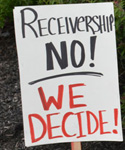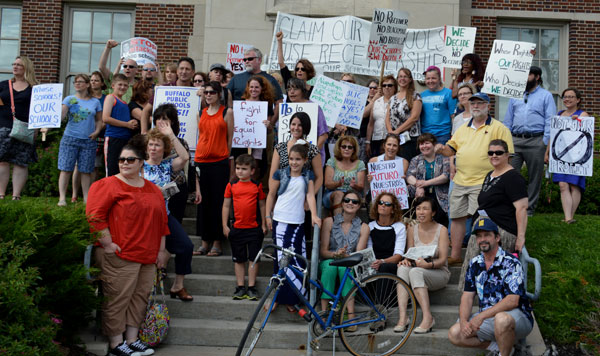Our Schools, We Decide
•
Who Decides for “Community Engagement Teams”
• School #6 Demonstration Against Receivership Shows the Way Forward
Who Decides for “Community Engagement Teams”
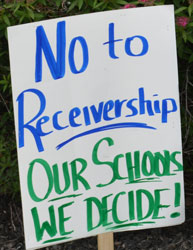 New York State, through both Cuomo’s law establishing receivership, and the Commissioner’s regulations for them, has made a considerable effort to present the law’s Community Engagement Teams (CET’s) as a way for teachers, students, parents and the public at large to have a significant role. This has been done mainly through presenting the fact that the CET’s are to include “the school principal, parents and guardians, teachers and other school staff and students,” as well as community members and community organizations with “direct ties” to the school (like Say Yes, for example). However, the fact that the CET’s have no decision making power and the fact that the receiver has final say about who its members are and how they can be removed, is ignored.
New York State, through both Cuomo’s law establishing receivership, and the Commissioner’s regulations for them, has made a considerable effort to present the law’s Community Engagement Teams (CET’s) as a way for teachers, students, parents and the public at large to have a significant role. This has been done mainly through presenting the fact that the CET’s are to include “the school principal, parents and guardians, teachers and other school staff and students,” as well as community members and community organizations with “direct ties” to the school (like Say Yes, for example). However, the fact that the CET’s have no decision making power and the fact that the receiver has final say about who its members are and how they can be removed, is ignored.
Consider the following. In her July 16 statement Commissioner Elia said, “Superintendents will now begin the process of creating community engagement teams to advise the superintendent regarding development and implementation of improvement plans.” This statement clarifies the more vague statement made in the law itself, that “the district” will establish the CETs. Elia makes clear the “district” means the Superintendent, who is now the receiver for 25 Buffalo schools.
The law speaks both to CET composition and to the fact that the CETs make only recommendations, not decisions: “The district shall establish a community engagement team which shall include stakeholders, including but not limited to the school principal, parents and guardians, teachers and other school staff and students. Membership of such teams may be modified at any time. Such team shall develop recommendations for improvement of the school and shall solicit input through public engagement. The team shall present its recommendations periodically to the school leadership and, as applicable, the receiver,” (para 211-f, c-iii).
The Commissioner’s regulations state that the receiver decides how people are chosen and removed:
“In creating the community engagement plan, the Superintendent must describe, in addition to how members of the CET are selected, how the CET membership may be modified or vacancies filled.” (June 15 Revised Regulations on School Receivership, p.4)
This content makes clear that the receiver makes final decisions and appointments to the CETs. That the receiver can choose to have more or less participation is the case, but he decides, “how members of the CET are selected.”
Role of 1994 Regulations
To cause further confusion, however, the Commissioner’s regulations also state: “The Community Engagement Team (CET) must be created in accordance with the provisions of Commissioner’s Regulation 100.11 and include representatives with direct ties to the school.” The main relevant section from these older regulations states:
“b. By February 1, 1994, each public school district board of education… shall develop and adopt a district plan for the participation by teachers and parents with administrators and school board members in school-based planning and shared decision making. Such district plan shall be developed in collaboration with a committee composed of the superintendent of schools, administrators selected by the district's administrative bargaining organization(s), teachers selected by the teachers' collective bargaining organization(s), and parents (not employed by the district or a collective bargaining organization representing teachers or administrators in the district) selected by school-related parent organizations…”
It is notable here that these regulations say nothing about how “students, as well as community members and community organizations with “direct ties” to the school,” are to be selected. That is up to the receiver.
It is also the case that the schools already have Site-Based Management Teams (SBMTs), consistent with the 1994 100.11 regulations. These include administration, teachers and parents and may also include students and community members. It is possible the receiver will design a process that appoints the existing SBMTs for the CET, plus others as he sees fit. One indication of this is that according to teachers at the receivership schools, NYSED is already calling leaders of their SBMT teams, administrator and parent facilitator to Albany to tell them about how receivership will work. Another indication is the time-limit, from the Commissioner's regulations, of "20 business days" to establish the CETs for all 25 schools.
As well, given that the receiver also decides “how the CET membership may be modified,” something that can be done “at any time,” the receiver could use the SBMT's or people similarly selected by the unions and than remove people, such as those who do not sufficiently submit to the receiver’s plans. The point is the receiver decides.
Further, the existing “school-related parent organizations” recognized by the district means various other organizations among parents (and students) may not be included at all. This was evident in the recent invitation only meeting held by Commissioner Elia, where the recognized District Parent Coordinating Council (DPCC) was invited while others were not. Nothing in the regulations prevents such exclusion. Indeed, given the years of experience with this regulation, exclusion of some and inclusion of others, as decided by the Commissioner and/or receiver will likely take place.
Nowhere in the law or regulations does it call for decision making by teachers, staff, parents and students. There will be public meetings, but these are for the purpose of explaining why the school is under receivership and possibly taking questions — but not for decision making.
 Experience Shows Even Consultation Will Be Minimal
Experience Shows Even Consultation Will Be Minimal
As well, the long experience has been that even the consultation, collaboration and what is called “shared-decision making” required in the 1994 regulations has not been taking place. This was evident in Dr. Orfield’s report, for example, where he speaks to the need to change the parent involvement process and address the lack of parent information, complex process for participating, for applying to schools, etc. — issues parents have long demanded solutions for. Further, the DPCC has repeatedly put forward that the consultation required has not been taking place. All of this is unjust and undemocratic and indicative of what can now be expected of the receiver. Indeed, given his powers, conditions will be far more undemocratic and dictatorial.
Our Schools, We Decide
The CETs are a means to take initiative out of the hands of the currently broadly organized and mobilized public and put it into the hands of the receiver and commissioner. It is an effort to divide and divert the movement for the equal right to education for all, which has given the necessary starting point for raising the quality of our schools — decision making by the students, parents teachers and staff.
We, the public, the teachers, staff, students and parents, and those we consider experts as they serve the public interest, are the experts, the most informed, knowledgeable and experienced. Yet instead of enhancing and extending the role of the public, a very few people from each school are being relegated to helping the receiver put in place an undemocratic, anti-public education set up. It excludes the public from decision making and removes the receiver from public accountability.
The alternative is to keep initiative in our hands by organizing to Refuse Receivership! Rather than reacting to the state’s backward plans, let us persist in developing our own, including our own modern education. This means directing our time and resources to conducting and fighting for our own organizing for parent involvement, our own organizing for increasing student involvement, our own proposals for evaluating teachers and students, our own community surveys and needs assessments, our own workshops and public forums. We are the experts, we are the ones who affirm the equal right to education for all, we are the ones to decide!
[TOP]
School #6 Demonstration Against Receivership Shows the Way Forward
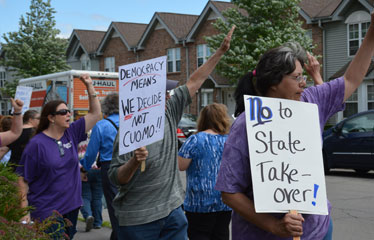
![]()
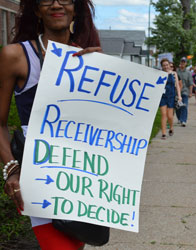
At recent demonstration at School #6, Buffalo Elementary School of Technology, now under receivership, teachers, students and community supporters stood together to say Refuse Receivership! The action brought together teachers from school #6 as well as others from the district. Together participants rejected recievership as undemocratic and a takeover by the state that harms public education and removes the most important ingrediant for raising the quality of the schools — decision making by the teachers, staff, parents and students.
The united stand counters the plan, under receivership, to separate each of the targetted schools and force teachers, staff and students to contend with receivership on their own. In particular, the receiver can impose a "receivership agreement" on each school that deals with such things as class size, curriculum, teaching conditions, assignments, length of school day and year. While these agreements are to be negotiated with the union, if teachers reject the agreement, or issues remain unresolved, the Commissioner will decide. This is not good faith bargaining, it is dictate by an appointed individual.
The state is attempting to split and divide the collective strength of teachers, as a district-wide force, as well as that of parents and teachers. Demonstrators said No! Refuse Recievership! Our Schools, We Decide! By taking action to unite more broadly to refuse, the demonstration showed the way forward.
Receivership is a brutal attack on the equal right to education for all and a state takeover that blocks teachers, staff, parents and students from deciding. It is supposed to be a means to improve the quality of the public schools. But it does not even address some of the most significant problems, such as inequality and poverty and the need to modernize public education. It does not address the great lack of state funds that is forcing schools to eliminate their music programs, that means there is not physical education for all, that means larger classes, that means greater hardship for the schools most in need, such as those now under receivership.
The state is using the blackmail of $75 million statewide for the "persistantly low achieving," oops no its "persistanly failing" oops no now its "persistanly struggling" schools. School #6 is one such school in Buffalo, which has 5 total for this year (25 schools in all under receivership). It might receive a $2-3 million if it is approved, by the state, for a grant. However, there is nothing to say the designated funds will actually reach the classroom or in any way address inequality. This is all the more true given that the Commissioner's regulations state these funds "will not be used to fund, in whole or in part, existing programs and services including but not limited to staff salaries." This means they cannot be used to keep or expand existing music and after school programs, the much needed additional English as a Second Language (ESL) teachers and translators, reading programs, etc. They can, however, be used to pay an outside agency contracted to provide "wrap around" social services. There is no language in the law or regulations that requires the majority of funds to reach the classroom. If past experience is any indicator, acutal funds reaching students in the classroom will be very limited.
The demonstration brought to the fore that the people themselves have much better solutions and they are the ones who should be given power to decide, not a receiver!
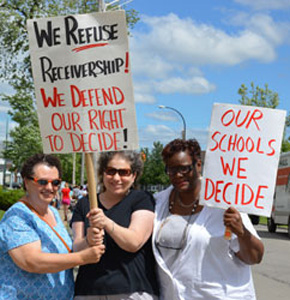
![]()
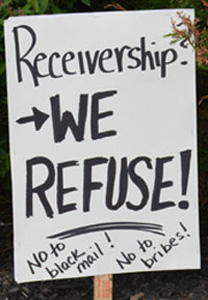
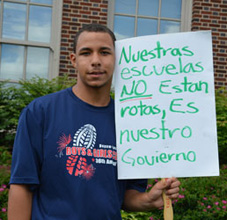
![]()
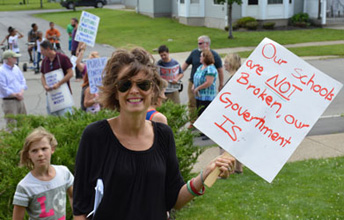
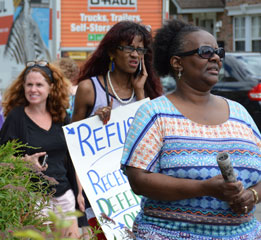
![]()
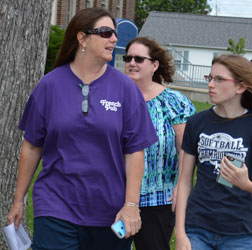
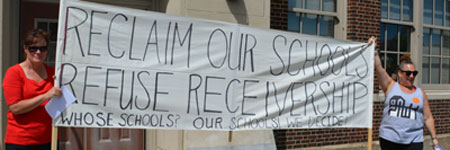
![]()
